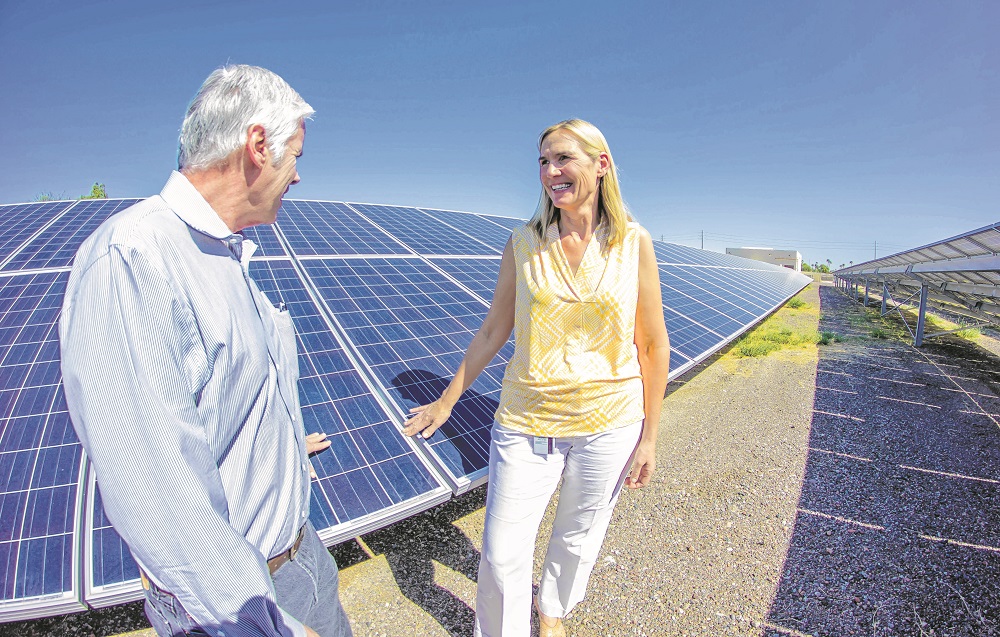
By Joyce Coronel
Here in the sunny Southwest, the rays of the sun are plentiful. Beyond bringing winter visitors, they’re also helping power the future.
Tempe Public Library will soon have solar panels that are designed to supply 35 percent of the complex’s energy needs. The effort began this month and is due to be completed in December.
Grace Kelly Del Monte, the engineer who’s managing the project, said the solar panels serve a two-fold purpose.
“We have shade structures in this project and it’s going to reduce the urban heat island impact,” Del Monte said.
That’s because five solar carport canopies will provide 262 shaded parking spaces for patrons. There will also be five shaded, wheelchair-accessible parking spaces near the library entrance. And the large, north-side canopy can also be used as a community gathering space for festivals, events, farmers markets and food trucks.
“We definitely see it as an opportunity to provide clean energy to our facilities and to reduce our carbon footprint by just producing energy on site,” Del Monte said.
John Osgood, of Tempe’s Sustainability and Renewal Initiative, said the project represents an investment in the city’s future.
“From a high-level perspective, electricity and power is generated pretty much from non-renewable sources like petroleum and natural gas. Someday those resources are not going to be available,” Osgood said.
“As much as we can, we look to the future and to the next generation, and make sure that we do what we can to produce clean energy using renewable sources.”
Last year, the Tempe City Council identified a goal of having 20 percent of its municipal operation energy produced by renewable sources by 2025.
The 486 solar panels that will soon be atop the library building are one way of helping to meet that goal. The solar energy will save the city some $95,000 in utility costs over the next 20 years and increases the city’s renewable energy use from 3 percent to 5 percent.
The solar panels are said to be capable of producing 1.3 million kilowatt hours of energy, which is equivalent to reducing carbon emissions by more than 900 metric tons and taking 190 vehicles off the road each year.
The total capital cost for the undertaking is $134,920 and is funded from the city’s capital improvement projects budget.
Tempe already uses solar to power part of the utility needs at the police and court building in the downtown area and has saved $14,000 in four months. Solar power is also being used at Tempe’s South Water Treatment Plant, where it provides 15 percent of the plant’s energy and is expected to save $2.3 million over 20 years.
While the city has embraced solar as a sustainable solution to energy needs, Tempe residents and some business owners have also been adding solar panels to their properties over the last several years. Tax credits and rebates, as well as concern about the environment, have fueled the development.
Mary Contreras, longtime owner of a Tempe-based State Farm insurance agency, was one of the early adopters of SRP’s solar energy program when, in 2008, she had solar panels installed on the rooftop of her office building in Warner Century Plaza, on Warner Road just west of the Price/101 freeway.
“It was a great decision because our savings have ranged from $200 to $300 every month for the seven years since the panels were installed,” said Contreras. And, she notes, never once in those years has the system required even the most minor repairs or adjustments.
At the time she made the decision to go with solar, Contreras says, hers was the only small-business installation among 200 other applications, most of which were on residential properties. At the time, Contreras says, SRP was attempting to satisfy a requirement for it to expand its solar offerings, and the cost seemed to be one she could amortize over the long run.
As to her satisfaction with the service, Contreras notes:
“I liked it so much I had it installed at home, and we have the same cost effectiveness and reliability there as we do in our offices.”
Contreras is no stranger to alternative concepts of alternative energy. Her father, a rancher in rural South Dakota, has served on the local rural electric board for many years and has seen the evolution of geothermal approaches to energy usage, a process based on an alternative system but with a like objective: to reduce the nation’s reliance on fossil-based fuel to meet its growing energy needs.
As to the work underway at Tempe’s library complex, it is part of the city’s ongoing efforts to reduce the carbon footprint.
“It’s in the context of landscape masterplan to kind of reinvigorate and bring new life into the campus there, primarily in terms of trees that have died and trees that need some refreshing,” Osgood said. “It’s all part of that capital project.”


